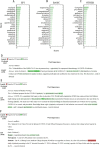Ensemble of deep learning language models to support the creation of living systematic reviews for the COVID-19 literature
- PMID: 37277872
- PMCID: PMC10240481
- DOI: 10.1186/s13643-023-02247-9
Ensemble of deep learning language models to support the creation of living systematic reviews for the COVID-19 literature
Abstract
Background: The COVID-19 pandemic has led to an unprecedented amount of scientific publications, growing at a pace never seen before. Multiple living systematic reviews have been developed to assist professionals with up-to-date and trustworthy health information, but it is increasingly challenging for systematic reviewers to keep up with the evidence in electronic databases. We aimed to investigate deep learning-based machine learning algorithms to classify COVID-19-related publications to help scale up the epidemiological curation process.
Methods: In this retrospective study, five different pre-trained deep learning-based language models were fine-tuned on a dataset of 6365 publications manually classified into two classes, three subclasses, and 22 sub-subclasses relevant for epidemiological triage purposes. In a k-fold cross-validation setting, each standalone model was assessed on a classification task and compared against an ensemble, which takes the standalone model predictions as input and uses different strategies to infer the optimal article class. A ranking task was also considered, in which the model outputs a ranked list of sub-subclasses associated with the article.
Results: The ensemble model significantly outperformed the standalone classifiers, achieving a F1-score of 89.2 at the class level of the classification task. The difference between the standalone and ensemble models increases at the sub-subclass level, where the ensemble reaches a micro F1-score of 70% against 67% for the best-performing standalone model. For the ranking task, the ensemble obtained the highest recall@3, with a performance of 89%. Using an unanimity voting rule, the ensemble can provide predictions with higher confidence on a subset of the data, achieving detection of original papers with a F1-score up to 97% on a subset of 80% of the collection instead of 93% on the whole dataset.
Conclusion: This study shows the potential of using deep learning language models to perform triage of COVID-19 references efficiently and support epidemiological curation and review. The ensemble consistently and significantly outperforms any standalone model. Fine-tuning the voting strategy thresholds is an interesting alternative to annotate a subset with higher predictive confidence.
Keywords: COVID-19; Deep learning; Language model; Literature screening; Living systematic review; Text classification; Transfer learning.
© 2023. The Author(s).
Conflict of interest statement
The authors declare that they have no competing interests.
Figures






References
-
- Lu Wang L, Lo K, Chandrasekhar Y, Reas R, Yang J, Eide D, et al. CORD-19: the Covid-19 Open Research Dataset. 2020 Available from: https://search.bvsalud.org/global-literature-on-novel-coronavirus-2019-n.... [Cited 29 Jun 2022].
-
- Counotte M, Imeri H, Leonie H, Ipekci M, Low N. Living evidence on COVID-19. 2020 Available from: https://ispmbern.github.io/covid-19/living-review/. [Cited 29 Jun 2022].
-
- The COVID-NMA initiative. Available from: https://covid-nma.com/. [Cited 29 Jun 2022].

